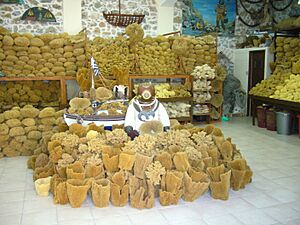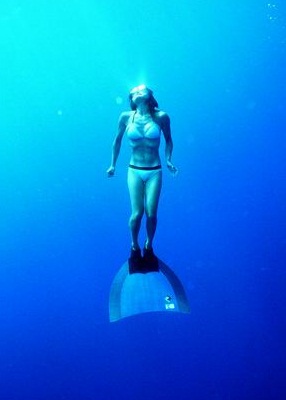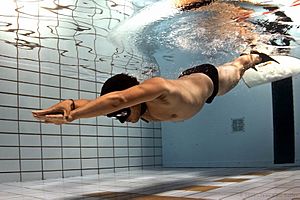Free diving facts for kids
Freediving is a way of diving underwater without using special breathing gear like air tanks. Instead, freedivers hold their breath for as long as they can. It's a challenging sport that lets people explore the underwater world quietly and naturally.
Most freedivers can stay underwater for about 45 seconds. This allows them to reach depths of around 30 feet (about 9 meters). Many amazing sea creatures and plants live at these depths, making it a great place to explore.
To freedive safely, people use some basic equipment. This includes a mask to see clearly, a snorkel for breathing at the surface, fins to help them swim faster, a wetsuit to stay warm, and a weightbelt to help them dive down easily.
While freediving is exciting, it also has risks. Divers must be well-trained to avoid dangers like feeling panicked underwater or passing out because they don't have enough oxygen. It's very important to learn from experts and never dive alone.
History of Freediving

People have been diving underwater for a very long time, even in ancient times. They would dive to find valuable items that had sunk, or to help with military campaigns. Back then, freediving was the only way to go underwater, except for using simple tools like reeds or leather bags to hold air. Divers in ancient times faced similar dangers to divers today, such as getting sick from pressure changes or blacking out from holding their breath too long. Because of these risks, diving long ago could be quite dangerous.
Commercial diving, where people dive to earn money, might have started in Ancient Greece. Famous thinkers like Plato and Homer wrote about sponges being used for bathing. The island of Kalymnos was a major center for collecting sponges. Divers would use heavy stones called skandalopetra, weighing up to 15 kilograms (about 33 pounds), to help them sink faster. They would dive as deep as 30 meters (about 100 feet) and hold their breath for up to 5 minutes to gather sponges.
Besides sponges, other valuable things found on the sea floor included red coral, valuable shells, and fish. This created a demand for divers to collect these treasures. The Ama Divers in Japan, for example, started collecting pearls about 2,000 years ago.
The Mediterranean region was a busy place for sea trade. This meant many shipwrecks occurred. Divers were often hired to salvage, or rescue, anything valuable from these sunken ships. They would swim down to the wreck and choose the most important items to bring up. These salvage divers faced many dangers. Because of this, laws like the Lex Rhodia were created. These laws gave divers a large share of what they salvaged. For example, if a wreck was deeper than 50 feet, divers received one-third of the salvaged goods. If it was deeper than 90 feet, they received half.
Divers were also important in ancient wars. They helped create defenses against enemy ships, like underwater barricades designed to sink them. Since these barricades were hidden, divers would scout the seabed when enemy ships approached a harbor. If found, divers would try to take them apart. During the Peloponnesian War, divers swam past enemy blockades to deliver messages and supplies to allies or troops who were cut off. These ancient frogmen also acted as saboteurs, making holes in enemy ship hulls, cutting their rigging, and loosening their moorings.
What is Freediving?
Freediving is a skill used in many different water activities. Some well-known freediving activities include competitive freediving, spearfishing (with or without competitions), taking photography underwater, and even mermaid shows. Other activities that use freediving skills, but are less commonly called "freediving," include synchronized swimming, underwater rugby, underwater hockey, and snorkeling.
There is still some discussion about whether "freediving" means only holding your breath underwater, or if it refers to a specific group of underwater sports. Often, the term "freediving" is used to describe competitive breath-hold diving, also known as competitive apnea.
Competitive Freediving
Competitive freediving is managed by two main international groups: AIDA International (which stands for the International Association for Development of Apnea) and CMAS (the World Underwater Federation).
Most competitive freediving events are individual sports. This means each diver tries to achieve their best personal result. One exception is the World Championship for Teams, held by AIDA every two years. In this event, the scores of all team members are added together to get the team's total points.
Currently, there are nine official freediving disciplines recognized by these groups, plus many others practiced in local areas. This article will focus on the disciplines recognized by AIDA and CMAS. Both men and women can compete in all disciplines. While competitions can happen outdoors, there are no longer different records based on the environment. AIDA disciplines can be done in competitions or as attempts to set new records, except for Variable Weight and No Limits, which are only for record attempts.
Images for kids
See also
 In Spanish: Apnea (deporte) para niños
In Spanish: Apnea (deporte) para niños








